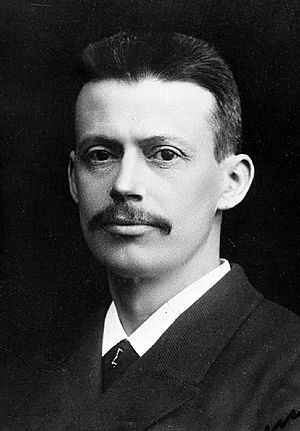Niels Ryberg Finsen facts for kids
Quick facts for kids
Niels Ryberg Finsen
|
|
|---|---|
 |
|
| Born | 15 December 1860 |
| Died | 24 September 1904 (aged 43) |
| Alma mater | University of Copenhagen |
| Known for | Phototherapy |
| Awards | Nobel Prize in Physiology or Medicine (1903) Cameron Prize for Therapeutics of the University of Edinburgh (1904) |
Niels Ryberg Finsen (born December 15, 1860, died September 24, 1904) was a doctor and scientist from the Faroe Islands and Iceland. He won the Nobel Prize in Medicine in 1903. He received this award for his amazing work using concentrated light to treat diseases, especially a skin condition called lupus vulgaris. His discoveries opened up a whole new way to use light in medicine.
Contents
Early Life and Education
Niels Finsen was born in Tórshavn, Faroe Islands. He was the second of four children. His father, Hannes Finsen, came from an old Icelandic family. His mother, Johanne Formann, was from Denmark.
His family moved to Tórshavn in 1858. This was because his father became a Landfoged, which was a high government official. When Niels was four, his mother passed away. His father then married his mother's cousin, Birgitte Kirstine Formann. They had six more children together. In 1871, Niels's father became the Amtmand (governor) of the Faroe Islands.
School Days
Niels started his education in Tórshavn. In 1874, he went to a Danish boarding school called Herlufsholm. His older brother, Olaf, also studied there. Niels found it hard at Herlufsholm. The principal even said he was "a boy of good heart but low skills and energy."
Because of his low grades and trouble with the Danish language, he was sent to Iceland in 1876. He enrolled in his father's old school, Lærði skólinn, in Reykjavík. He graduated when he was 21 years old, finishing 11th out of 15 students.
Becoming a Doctor
In 1882, Finsen moved to Copenhagen, Denmark. He studied medicine at the University of Copenhagen and graduated in 1890. Because he had studied in Iceland, he got special entry into Regensen. This is a very famous college dormitory in Denmark. This was part of a government plan to help students from its colonies connect with the university in Copenhagen.
After graduating, he worked as an anatomy assistant at the university. Three years later, he left this job to focus completely on his scientific research. In 1898, Finsen became a professor. In 1899, he was made a Knight of the Order of Dannebrog, which is a special honor.
Pioneering Light Therapy
The Finsen Institute was started in 1896. Finsen was its first director. This institute later joined the Copenhagen University Hospital. Today, it is a cancer research lab.
Finsen had a serious illness called Niemann–Pick disease. This illness made him very interested in how light affects living things. He started sunbathing and researching light. This led him to develop a new idea called phototherapy. He believed that certain types of light could help treat illnesses.
His most important writings were Finsen Om Lysets Indvirkninger paa Huden (which means "On the effects of light on the skin"), published in 1893. Another key work was Om Anvendelse i Medicinen af koncentrerede kemiske Lysstraaler ("The use of concentrated chemical light rays in medicine"), published in 1896. These papers were quickly translated into German and French. He also studied the effects of sodium chloride (table salt). He looked at what happened when people ate a low-salt diet. He published his findings in 1904.
Nobel Prize and Recognition
Finsen won the Nobel Prize in Physiology or Medicine in 1903 for his work on phototherapy. He was the first person from Scandinavia to win this prize. He is still the only Nobel winner in physiology from the Faroe Islands. In 1904, he also received the Cameron Prize for Therapeutics of the University of Edinburgh.
Personal Life and Legacy
Niels Finsen married Ingeborg Balslev on December 29, 1892.
Finsen's health started to get worse in the mid-1880s. He had heart problems and other issues that made him weak. His illness affected his body, but not his mind. He kept working from his wheelchair. He passed away in Copenhagen on September 24, 1904.
Memorials and Honors
Several places are named after Niels Finsen to remember his important work:
- The Finsen Laboratory at Copenhagen University Hospital is named in his honor.
- A street in Frederiksberg, Denmark, called Finsensvej, is also named after him.
- A large memorial statue of Finsen was put up in Copenhagen in 1909. It is called Mod lyset (Towards the Light). This sculpture shows his main idea that sunlight can help heal.
- In Tórshavn, Faroe Islands, there is also a memorial to Finsen. One of the city's main streets, Niels Finsens gøta, has his name. The old public school in Tórshavn, Kommunuskúlin, has been rebuilt into student housing and renamed Finsen.
See also
 In Spanish: Niels Ryberg Finsen para niños
In Spanish: Niels Ryberg Finsen para niños

